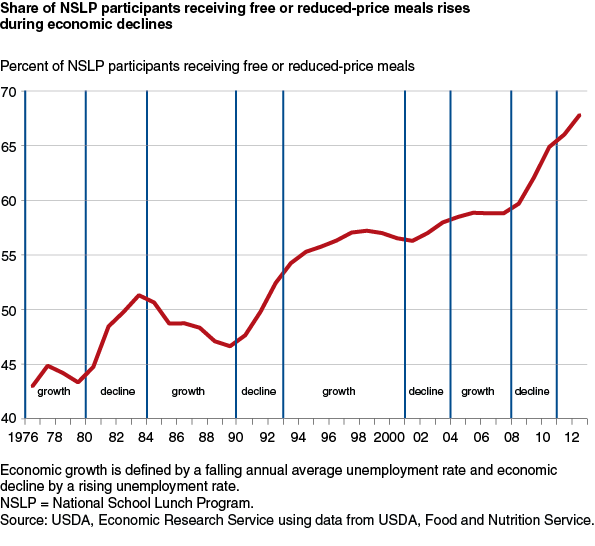Economic Conditions Affect the Share of Children Receiving Free or Reduced-Price School Lunches
- by Kenneth Hanson and Victor Oliveira
- 5/6/2013
USDA’s Supplemental Nutrition Assistance Program (SNAP, formerly the Food Stamp Program) is recognized as one of the Nation’s primary countercyclical assistance programs, expanding during economic downturns and contracting during periods of economic growth. However, there has been little analysis of the effect of the economy on other food and nutrition assistance programs. A recent ERS study examined USDA’s National School Lunch Program (NSLP) and other USDA nutrition assistance programs and found that they also respond to the changing needs of households during periods of economic downturn and growth.
NSLP is the Nation’s second-largest food and nutrition assistance program. In fiscal year 2012, expenditures totaled $11.6 billion and an average 31.6 million children participated in the program on a typical day of school. The program subsidizes meals in participating schools, which must offer nutritious meals to any student at full price and to income-eligible students for free or at a reduced price. Total participation in NSLP is closely linked to school enrollment and does not vary with economic conditions. Since the mid-1980s, total participation has grown steadily at an annual average rate of 1.1 percent per year, following the growth in school enrollment.
While total participation in NSLP is independent of economic conditions, the share of participants receiving free or reduced-price meals is responsive to the economy, rising with the unemployment rate during downturns. During the Great Recession of December 2007 to June 2009 and continuing through 2010, the share of NSLP participants receiving free or reduced-price meals increased 10 percent. This growth was due to both more children receiving free or reduced-price meals and fewer children paying for full-price meals. The declining number of children paying full price reflects children who shifted to free and reduced-price lunches and others who may have shifted to bringing their lunches from home. During 2008-10, the average daily number of children receiving free or reduced-price lunches increased from 18.1 million to 20.6 million. In fiscal year 2010, 65 percent of NSLP participants received free or reduced-price meals, compared with 59 percent in fiscal year 2007, before the recession.
Preliminary data for fiscal years 2011 and 2012 show that the share of children receiving free or reduced-price meals continued to rise even after the unemployment rate started to decline. SNAP participation also rose during the same period. Past research into the cause of a lag in the response of SNAP participation to the unemployment rate during the early stages of economic recovery suggests that real wages and job opportunities for less-skilled workers did not improve enough to raise people out of poverty and the need for assistance remained high.
This article is drawn from:
- Hanson, K. & Oliveira, V. (2012). How Economic Conditions Affect Participation in USDA Nutrition Assistance Programs. U.S. Department of Agriculture, Economic Research Service. EIB-100.
You may also like:
- Child Nutrition Programs. (n.d.). U.S. Department of Agriculture, Economic Research Service.


